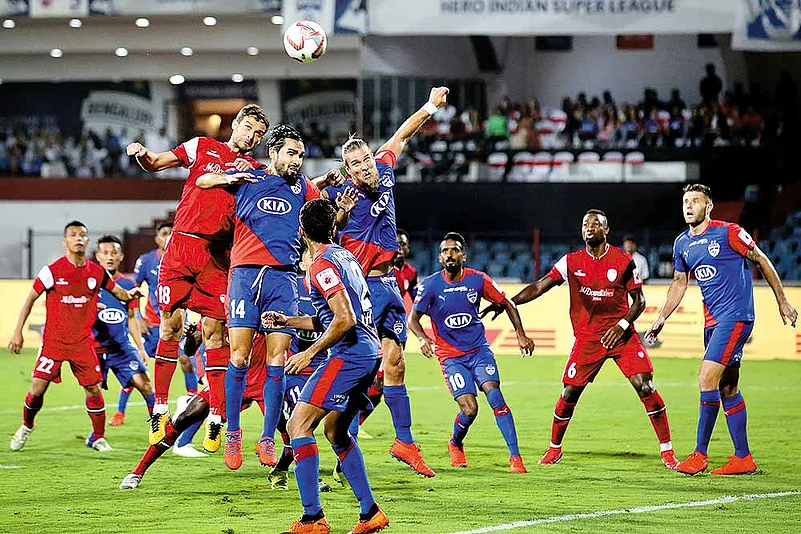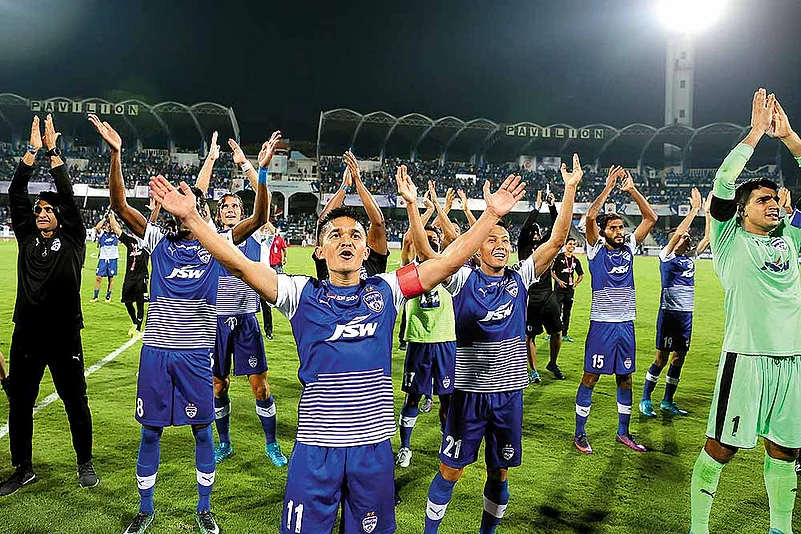July 9, 2019 could be a momentous date in Indian football’s recent history. While it could pitchfork the relatively new Indian Super League as the nation’s No. 1 football league, it could also endanger the future of century-old clubs like Mohun Bagan, East Bengal and a clutch of legacy Goan outfits like Churchill Brothers. Dethroning the I-League, still recognised as India’s national competition by the Asian Football Confederation and FIFA, will mean low-budget but extremely popular teams from the Northeast and Punjab that are applauded for their robust football may even cease to exist.
A weak All India Football Federation executive committee is caught between its very influential commercial partner—Reliance—and clubs that have nourished and kept the game alive ever since Shibdas Bhaduri captained Mohun Bagan to victory in the 1911 IFA Shield final against the East Yorkshire Regiment. Much of the romance of the beautiful game in India is tied to local clubs great and small: the exhilarating, demotic pull of a Mohun Bagan versus East Bengal match, with heaving bleachers crammed with 1,00,000 fans, or the ardent Messi-loving Manipuri or Mizo kid dribbling obsessively all day. Consequently, much is at stake if the AIFF’s commercial partners muscle their way through in making ISL India’s premier league.
Football in India is virtually in the grips of the Football Sports Development Limited (FSDL). Founded in 2014, it is a subsidiary of AIFF’s commercial partner Reliance, which runs the glitzy ISL, a cosy ‘closed league’ with no promotion or relegation—something rare in world football. Eight FSDL officials hold key positions in AIFF committees, allowing Reliance to dictate terms. Dissent within the AIFF is ineffective as president Praful Patel and secretary Kushal Das don’t have the temerity to look Reliance in the eye.

Foreign imports in the ISL have often disappointed
The strength of Indian football lies in its club system, and teams from Calcutta, Goa, Mumbai, Hyderabad, Kerala and Punjab have had a passionate following spanning generations, rivalling that of Manchester United or Real Madrid. Their very importance threatened, a union of at least eight I-league teams, including East Bengal, Bagan, Churchill Brothers, current champions Chennai City FC, Minerva Punjab FC, Aizwal from Northeast and Gokulam Kerala are now revolting against Reliance’s attempt to “kill club football”.
As a mark of protest, several clubs skipped the 2019 Super Cup competition and are facing absurd fines of at least Rs 27.5 lakh each. The clubs feel a cash-rich FSDL is overshooting its brief.
In the middle of the muddle is the AIFF. In 2005, the federation signed a 10-year Master Rights Agreement (MRA) with Zee, receiving Rs 28-36 crore annually. But in 2010, IMG-Reliance (now just Reliance) bought off the contract from Zee for Rs 70 crore and signed a fresh 15-year deal (till 2025) with the AIFF. This new contract meant the AIFF would get more money from its commercial partners. Reliance paid around Rs 35 crore annually to AIFF till 2015. Currently, it pays around Rs 50 crore in four quarterly instalments.
“When the MRA was signed with Reliance, AIFF was under the impression that the I-league would be restructured and become bigger. Of course, there was a provision for a “new league that would become the seniormost and prestigious” competition. Never thought ISL will become a Frankenstein’s monster,” says a well-placed source.
Planned along the lines of cricket’s IPL, ISL started in 2014 with eight teams. With aggressive marketing, Bollywood glamour and live telecast on STAR, it became an instant hit. Quite a few over-the-hill internationals like Frenchmen David Trezeguet and Robert Pires, Italian Alessandro Nesta, Brazilian Roberto Carlos and Alessandro Del Piero of Italy were paid whopping amounts by franchises. The tournament started losing its popularity over the years, with attendances falling drastically. On the other hand, I-League showed a significant increase of about 58 per cent, as fans in Mizoram and Meghalaya turned up in huge numbers.
Interestingly, in 2014, FIFA general secretary Jerome Valcke told the media that the ISL was just a tournament, not a league. On the same occasion, Patel said ISL was a “booster league” and that the I-League will remain priority. With no recognition for the ISL from the Asian Football Confederation either, I-League, to Reliance’s dismay, remained India’s premier league.
The ISL certainly didn’t dim the popularity of the I-League. It connected better with regional fans, especially in the Northeast, as Lajong FC, NEROCA and Aizawl FC became new powerhouses. Bengaluru FC and Chennai City FC were the new bastions in the south, while Minerva of Punjab and Real Kashmir represented northern might. The fans loved it, as did the media, as FSDL’s antipathy towards the I-League league started showing.
To undermine the I-League teams and prove that ISL teams were better, the Super Cup was born in 2018. Even there, I-League teams proved to be better. More cohesive, less commercial and imbued with passion, even an age-group team like Indian Arrows upset ISL giants Kerala Blasters and Chennai City FC defeated Bengaluru FC, a past winner of the I-League. In 2019, the Super Cup lost its sheen after seven top I-league teams abstained.
For sheer lack of a roadmap from the FSDL, the AIFF could not face the rebellious I-League teams for months. Expectedly, Patel remained elusive. Secretary Das never had clarity. Minerva’s boss Ranjit Bajaj points out the flaws in the MRA: “The agreement…has conflict of interest and violates basic FIFA rules. FIFA’s Article 19.1, 19.2 and 19.3 clearly say a league must have promotion and relegation; ISL doesn’t encourage new teams and restricts participation by asking for massive franchise fees (Rs 15 crore each).”
“Closing down promotion and relegation is a dangerous trait. It is better if the marketing partner’s influence is less in a national federation like AIFF. Otherwise, AIFF should stop accepting grants from the SAI,” says football writer Jaidip Basu.
With nothing working in its favour, FSDL forced the AIFF to announce ISL’s new status as the main league. The I-League would then be relegated to Tier 1. Patel, now a member of the FIFA Council, is caught on a sticky wicket. With angry I-League clubs threatening to go to court, he is looking for a compromise.
It is learnt that the FSDL has blocked its funds to the AIFF. Two quarterly payments of Rs 12.5 crore each have not been paid. “It’s a clear message. Reliance believes money talks and that will kill any resistance from AIFF bigwigs,” the source says. That’s unlikely to happen. A closed door meeting with I-League clubs on June 3 will try to find a compromise formula. If there is status quo, it will only prolong the debate.
The fear of a court battle may make the FSDL see some reason. What if the court appoints administrators like the Supreme Court did with the BCCI and leave the AIFF in limbo for years? The SC bench that continues to hear the BCCI case made one thing clear: “The sport is bigger than officials or its commercial partners”.
As of June 14, India are ranked 101 in the world. Both AIFF and FSDL must keep the health of Indian football in mind. A bad move will make Patel lose face in FIFA’s corridor of power. Adding that to the ranking makes it an unhappy state of affairs.
By Soumitra Bose & Neelav Chakravarti
















